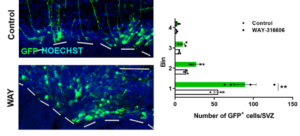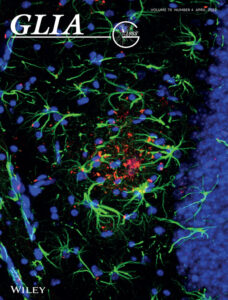KNAW membership of Elly Hol
Fantastic news from Elly Hol!! The Royal Netherlands Academy of Arts and Sciences (KNAW) announced that Prof. Elly Hol has been chosen as a new member. Members of the KNAW are leading scientists from all disciplines and are chosen on the basis of their scientific achievements. The KNAW has approximately 585 members. A membership is for life. In addition to Elly Hol, 21 other new members have been elected. The new members of the Academy will be installed on 12 September.

“I am very pleased with this recognition for my research on glia. I could not have done this research without the enormous efforts of all PhD students, post-docs, researchers, research analysts, and students who have worked in my group over the years in Amsterdam and Utrecht. It is also really nice to see how the group of glia researchers in the Netherlands and internationally has grown. The collaborations with (inter)national colleagues and the support of subsidy providers make it possible to discover new aspects of neuron-glia interactions in brain diseases. I am also very enthusiastic about new technologies, such as molecular single cell studies on human post-mortem brain material and functional studies in patient mini-brains, which are of great importance for my research on glia in brain diseases.”
We are deeply honoured to have Elly Hol as a group leader at the Translational Neuroscience Department of the UMC Utrecht Brain Center of the UMCU
See the new on the KNAW or Utrecht University webpages
PhD defence of Andreia Duarte and Lieke van de Haar

PhD defence is a special occasion celebrating not only the graduation of a student but also the society gaining a new highly trained specialist. Last week, Andreia Duarte and Lieke van de Haar of the Pasterkamp lab have defended their PhD thesis with two in-person PhD defences at the Academiegebouw of the Utrecht University.
In her work “The Road Less Travelled: Exploring the profile and functions of non-coding RNAs in brain disease, Andreia has explored how circRNAs and tRNAs may facilitate the brain’s response in medial Temporal lobe epilepsy. She has started her new position as an R&D scientist at the VectorY.
“It was a great closure of 4.5 years of work with lots of research, learning, travelling, fun, ending in such an unforgettable day.” Andreia
Lieke built her PhD on a combination of wet lab experiments and computational tools. Her thesis titled “Isles of Molecules” defines the Habenula development at a single cell level and a new mechanism of axonal guidance. We wish her best luck in her new position as a postdoc at the Rajewsky lab at MDC, Germany.
“ It was a great day to celebrate 4,5 years of work at the University Medical Center Utrecht. I very much enjoyed the scientific discussions and having colleagues, friends and family around.” Lieke
The work was performed at our Translational Neuroscience department of the UMC Brain Center. Photographs by Daniëlle van Rossum and Bart van Dijk
Single-cell profiling adult human neural stem cells
Neural stem cells (NSCs) of the subventricular zone (SVZ) remain mostly in a dormant state in the adult human brain after closure of the neurogenic period at birth. These dormant progenitors rarely proliferate or produce neurons. How an adult human NSC is maintained in this quiescent state and could be triggered to re-activate is still unclear.

In this recent publication at Nature Communications, Vanessa Donega, Elly Hol and colleagues unravel a possible mechanism through which progenitors of the adult human SVZ are maintained in a dormant state. They used state-of-the-art single-cell RNA sequencing to profile the molecular characteristics of a major neural stem cell niche in the adult human brain. They identify the Wnt pathway antagonist SFRP1 as a possible signal that promotes neural stem cell quiescence in the aged human SVZ. Furthermore, they show that inhibition of SFRP1 stimulates neural stem cell activation both in vivo and in vitro. This work opens up future possibilities to stimulate neural stem cells of the human brain to promote repair.
“I am very happy that this work is out, and I am excited to continue investigating the role of SFRP1 in regulating neural stem cell quiescence.” Vanessa Donega
This work was performed primarily at our Translational Neuroscience department of the UMC Brain center. This work was supported by ZonMw, by the MAXOMOD consortium, a Ministry of Science and Technology of China grant, Theme-based Research Scheme, Health and Medical Research Fund and CUHK Direct Grant
Astrocyte function in early-stage Alzheimer’s disease on GLIA
 Astrocytes are literally the star cells of our brains! PhD candidate Christiaan Huffels, from the group of Elly Hol, recently published a study on astrocyte function in early-stage Alzheimer’s disease in the scientific journal GLIA.
Astrocytes are literally the star cells of our brains! PhD candidate Christiaan Huffels, from the group of Elly Hol, recently published a study on astrocyte function in early-stage Alzheimer’s disease in the scientific journal GLIA.
Alzheimer’s Disease is the main form of dementia in the elderly, characterised by the accumulation of amyloid-ß protein. In this study, Huffels and his colleagues examined the role of astrocyte function in Alzheimer’s Disease. They focused on Kir4.1 expression and function, which is an ion channel that is essential for the role of astrocytes in the maintenance of tissue ion homeostasis. Despite localised increase in Kir4.1 protein expression, astrocyte Kir4.1 channel dysfunction is likely not involved in the pathogenesis of early-stage Alzheimer’s disease. This study hereby provides more in-depth insight into the development of early-stage Alzheimer’s disease and provides directions for future research. After this study was accepted for publication, one of the images was selected for the cover of GLIA.
Christiaan was happily surprised: “I thought it was great that they asked me to provide an image for the cover and immediately agreed, as this can draw extra attention to the interesting study we performed.”
The research was primarily performed at our Translational Neuroscience Department at UMC Bran Center, in collaboration with the University of Amsterdam and University of Bonn. The study was supported by the University of Amsterdam, ZonMW, and Alzheimer Nederland.
Two tenure track assistant professor positions (EXPIRED ON 28-02-2022)
We are recruiting young talent for two tenure track assistant professor positions!
Tenure track assistant professor in cell and molecular neurobiology
A tenure track assistant professor position in molecular and cellular neurobiology is now open for applications! We seek outstanding candidates with an excellent track record in cellular or mouse (transgenic, viral-induced) models of human brain disease and with expertise in state-of-the-art genome editing and bioinformatics. The candidate should have an interest in neuron-glia interactions, development of brain circuits, and brain diseases. The relevant UMCU post is here.
Tenure track assistant professor in advanced human iPSC modeling
A tenure track assistant professor position in advanced human iPSC modeling is now open for applications! We seek an outstanding candidate with an excellent track record in cellular models of human brain disease (iPS cells, organoids) and associated state-of-the-art molecular (e.g. genome editing) and neurophysiological techniques (e.g. calcium imaging, patch-clamping, multiple-electrode arrays). The candidate should have an interest in neuron-glia interactions, development and function of brain circuits, and brain diseases. The relevant UMCU post is here.
Visit our recruitment page for more details.
